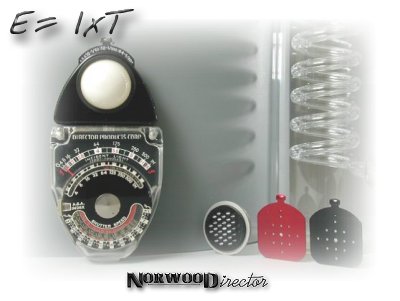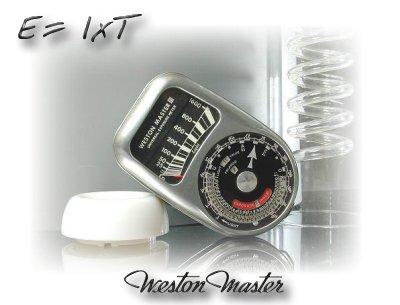

|
For the Director and Sekonic meters: High slide in - No need to use different slides!
|

|
Intensity, Exposure, and Time The area of the camera's aperture regulates the intensity. (i.e. cutting the aperture area in half, cuts the intensity in half; doubling the aperture area doubles the intensity). The shutter speed regulates the exposure time. For most films, the relationship E = I x T does not hold when the exposure time is very slow or extremely fast. Typically, most films require more exposure than the E = I x T formula indicates. This is called reciprocity failure. It can cause color distortion since it usually effects each color component differently. |


|
For the WestonMaster series I - IV: Invercone mounted - With these meters it works with reflected or incident light metering. Note: Low (Values 1sec - 1/50th sec.)and high scales (Values 1/25th. sec - 1/1600th sec.)can be used with this method.
|

|
For the math aficionados....! The Exposure Formula. (Excerpt from WestonMaster.com) A formula exists which, once learned, facilitates rapid exposure calculation mentally, without the need for setting dials on meters. It requires knowing luminance values in candles per square-foot, and unfortunately few, if any meters today are calibrated in these units.
Since the early Weston Master meters read directly in Cd/ft2, very rapid exposure determination was possible. Current meters can usually be calibrated in these units to facilitate the use of the Exposure-formula, as described below.(See Converting to candles per square foot above)
At the key stop, the correct shutter speed in seconds to expose a given luminance on Zone V [Kodak 18 % Neutral Grey Card], is the reciprocal of the luminance expressed in Cd/ft2.
An example.... One more example.... Your final exposure time will be thus 1/250 second at the key-stop, which we defined as f/22.
If you are familiar with these mental calculations, remember this one: |

 Sekonic Studio -S in action after revision( 6-9-2003) |
|
Measuring Incident light:
Checking Speed formula - Simultaneous metering on a sunny cloudy day around 1100 hours - Location Driebergen-R On the right side a spiffy WestonMaster III with Invercone mounted(high scale) & On the left side Sekonic Studio -S with Photosphere (High slide in).
As the Westonmaster scale is in cd/ft2 and the Sekonic in Foot-candle this does not influence the outcome.!
With this information and a film of 400ASA loaded, what would be the exposure/aperture combination?
Tell us
The above formulae are brought to you by JohnDesq - Driebergen-Rijsenburg, the Netherlands. |
See also the APEX system.

|
Author
||| Table of Content
||| History
||| Identification
||| Yesterday's Meters
||| HelioValve
||| Model M-3
||| M series
||| FaQ!!
||| Wanted!!
FC TEST ||| SlideShow ||| About slides ||| Condensed Manuals ||| Test Bench ||| Speed reading ||| Quiz ||| Impressum ||| Friends of ND ||| New Cell? Where to buy ||| Ranger 9 ||| E-Mail ||| History Menu ||| CD-ROM |
| Copyright Notice: All material located on this website is the copyrighted property of John D.Photography and or John D. de Vries (or as otherwise credited). This includies, but is not limited to, photographs, graphics and text files. This material may not be sampled, duplicated, reproduced, redistributed or re-transmitted in any form without the written permission of John D. de Vries/Johndesq Consultancy or their agents. © 2003 - John. D. Photography - WWW.johndesq.com |